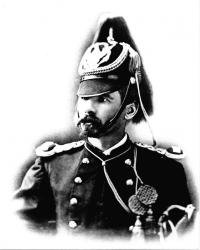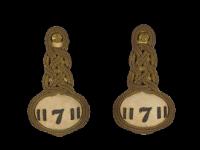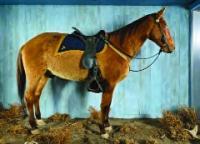Captain (brevet Lt.-Col.) Myles Walter Keogh
Published in 18th–19th - Century History, Features, Issue 4 (July/August 2011), Volume 19
Captain Myles Keogh in the dress uniform of the 7th US Cavalry and (insets) his shoulder knots and sabre. (Gene Autry Museum,
Los Angeles)
Myles Walter Keogh (1840–76) was born in Carlow on 25 March 1840 and was commissioned an officer in the Irish Battalion of the Papal Army on 7 August 1860. He helped defend the Papal States against Italian nationalists, serving at the siege of Ancona from 12 to 28 September 1860. He resigned his commission on 20 February 1862 and went to the United States, joining the US Army in April 1862. A year earlier the American Civil War had broken out between the Northern (Union) and Southern (Confederate) states and was to last four years, with 200,000 Irish-born soldiers fighting on the Union side in over 35 Irish regiments. By the end of the war Keogh had become a lieutenant-colonel, fighting at the Battle of Gettysburg in July 1863 and during the Atlanta campaign, where he served as aide-de-camp to Major General George Stoneman.
After the war Keogh stayed on in the US Army and with its reorganisation for peacetime service he lost his rank, becoming a captain in the 7th US Cavalry in 1866. He served in the Indian Wars and was killed with brevet Major-General George A. Custer and 250 soldiers of the 7th Cavalry in the battle against the Sioux and Cheyenne Indians on the Little Bighorn River, Montana, on 25 June 1876. Of the 845 soldiers in the 7th Cavalry at that time 136 were Irish-born, mostly privates and non-commissioned officers; Myles Walter Keogh was one of the few Irishofficers.
On display in the Soldiers & Chiefs Exhibition at the National Museum of Ireland are items belonging to
Myles Keogh, on loan from the Gene Autry Museum in California. These include his hat, worn on the papal service, and the sabre issued to him in 1862, along with his citizenship
papers. Also on display is a photograph of Keogh’s horse, Comanche, the only living thing found on the battlefield at the Little Bighorn after the action. Comanche became a regimental mascot for the 7th Cavalry; he was preserved when he died in 1890 and is now on display at the University of Kansas. After five years on display these items will be returning to Los Angles at the end of this summer. HI
Lar Joye is curator of military history at the National Museum of Ireland (Decorative Arts and History).


Keogh’s horse, Comanche—the only living thing found on the battlefield at the Little Bighorn after the action—became the 7th Cavalry’s regimental mascot and was preserved when he died in 1890. (University of Kansas)
















